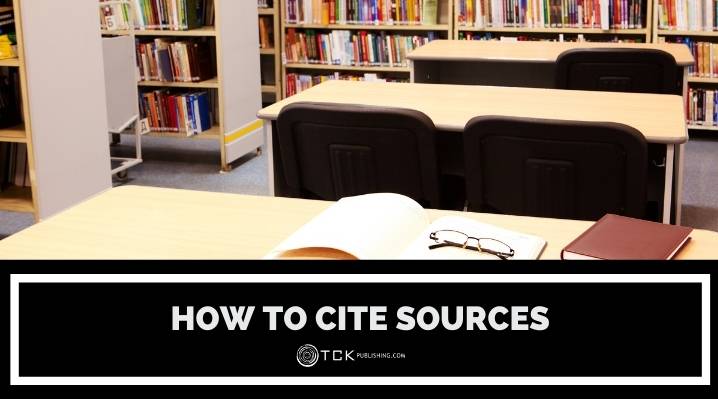
Whether you’re writing a research paper for school or working on your very own nonfiction book, one thing you’ll want to steer clear of is plagiarism.
In many cases, those who commit plagiarism do so unintentionally. The problem usually boils down to a misunderstanding of what constitutes plagiarism or a failure to properly cite sources.
To make sure you give credit where credit is due, it’s important to understand when citations are necessary and how you can include them in your work.
Types of Citations

So now that we’ve gone over when you should cite sources, let’s look at your options for formatting citations based on the rules of the most common style guides: MLA, Chicago, and APA.
Bibliography or Works Cited
Regardless of whether you refer to a source through parenthetical (“in-text”) citations, footnotes, or endnotes, most style guides will still require you to feature a complete bibliography or “Works Cited” page at the end of your paper.
Entries in a bibliography typically include the authors’ names, the titles of their works, their publishers, dates of publications, and specific page numbers, if applicable.
Depending on your style guide of choice, this document might be arranged alphabetically or in the order that the sources were mentioned.
Here’s an example of a bibliography entry for a book based on The Chicago Manual of Style‘s rules:
Foster, Thomas C. How to Read Literature Like a Professor: A Lively and Entertaining Guide to Reading Between the Lines. Perennial, 2014.
Parenthetical Citations
Parenthetical citations are used to refer to a source in the text, as opposed to using footnotes or endnotes to do so.
This type of in-text citation usually includes the author’s last name and the page number you’re referencing (if available), and depending on your style guide, the year the work was published. The rest of the source’s information will be included in a full citation in your Works Cited page or bibliography.
Example
- In literature, rain is hardly ever “just rain,” but rather a symbol for rebirth or renewal (Foster 2014, 42).
Endnotes
Endnotes are citations or explanations that are placed at the end of an article, chapter, or book. They are indicated by a superscript number, which corresponds with their numbered entry on the Endnotes page (which functions like a bibliography).
They look like this:
[1] Author first and last name, “Title of Page,” Website name, Publishing organization, publication or last modified date, URL.
Footnotes
Footnotes are just like endnotes, except they appear at the bottom (or “foot”) of the page. However, whereas endnotes are ideal for citations (since they don’t clutter the page), footnotes are best for providing supplementary information, or for papers with few citations, so readers don’t have to flip to the end of the text every time a footnote appears.
How to Cite Sources
Follow these 4 steps to create properly-formatted citations for your research.

1. Choose a style guide.
The first step toward creating properly formatted citations is knowing which style guide to follow. Your professor or publisher might have a preferred style guide that they’ll instruct you to use.
If not, you can choose one of the major guides to follow (AP, APA, Chicago, or MLA). The important thing is that you are consistent and abide by that style guide throughout the entirety of your paper.
2. Choose a type of citation.
Then, you’ll need to choose which type of citations to use (in-text, footnotes, endnotes, etc.) Again, your professor or publisher might have a preference, or you might be able to choose yourself, but you must be consistent.
In most cases, you’ll still need to include a bibliography or Works Cited page at the end with the full and complete citations.
3. Identify the source type.
Identify the type of source you’re referencing, as different types of sources are formatted differently. For example, the proper format for a website citation might call for different details than a book, interview, or scientific study.
Identify the type of source you’re using, so you can be sure to create the proper citation, or use a citation generator to do so.
4. Use a citation generator.
Speaking of citation generators, we highly recommend that you use one, as writing citations can be extremely time-consuming, and there are many details to include.
Online citation generators will allow you to select your style guide and type of source (most offer dozens of different source types, from government documents to radio interviews).
Then, you can either search for your source (for example, by ISBN if it’s a book) and the information will be automatically entered for you, or you can enter the information manually into the appropriate fields. From there, the generator will produce a properly-formatted citation that you can copy and paste or save for later.
When to Cite
Let’s review when you need to cite sources. Unless something is considered common knowledge, you’ll need to cite your sources for any ideas or information that aren’t yours.
Direct Quotes and Statistics
Whenever you include the exact words of someone else, you need to first put those words inside quotation marks (” “) to indicate that those words are not yours, and then cite the source.
You should also cite any statistics, data, figures, and facts that are not considered “common knowledge.” (For example, you wouldn’t need to cite the statement, “The United States achieved independence on July 4, 1776,” as this is common knowledge, or something that most people already know.)
Paraphrasing
Paraphrasing is when you use different words to express the same idea. You may think this wouldn’t require a citation, as you’re not actually using someone else’s words—but you’d be wrong.
Failure to cite statements that were paraphrased from someone else’s work can constitute plagiarism, so it’s important that you properly attribute a source even when you’ve used your own words to express the idea.
Mentioning or Summarizing Ideas of Others
In addition to paraphrasing, even just summarizing the ideas of others still requires a proper attribution. For example, you can’t just summarize the findings of a scientific study and let readers assume that you did the research yourself.
Examples of Citations for Common Sources
Below are examples of how to cite some of the most common sources (such as books and websites) in Chicago, APA, and MLA formats.
Books
The following are examples of how to cite print or digital books.
Chicago
Foster, Thomas C. How to Read Literature like a Professor: A Lively and Entertaining Guide to Reading Between the Lines. New York, NY: Harper Perennial, 2003.
APA
Foster, T. C. (2003). How to Read Literature Like a Professor: A Lively and Entertaining Guide to Reading Between the Lines. Harper Perennial.
MLA
Foster, Thomas C. How to Read Literature like a Professor: a Lively and Entertaining Guide to Reading Between the Lines. Harper Perennial, 2003.
Websites
Website citations usually include the site’s name and URL.
Chicago
Barron, Kaelyn. “How to Write a Research Paper.” TCK Publishing, July 31, 2019. https://www.tckpublishing.com/how-to-write-a-research-paper/.
APA
Barron, K. (2019, July 31). How to Write a Research Paper. TCK Publishing. https://www.tckpublishing.com/how-to-write-a-research-paper/.
MLA
Barron, Kaelyn. “How to Write a Research Paper.” TCK Publishing, 31 July 2019, www.tckpublishing.com/how-to-write-a-research-paper/.
Journal Articles
Sometimes, you may need to cite academic articles that you find in online databases or journals.
Chicago
Kahn, D., R. Stickgold, E. F. Pace-Schott, and J. A. Hobson. “Dreaming and Waking Consciousness: a Character Recognition Study.” Journal of Sleep Research 9, no. 4 (2000): 317–25. https://doi.org/10.1046/j.1365-2869.2000.00213.x.
APA
Kahn, D., Stickgold, R., Pace-Schott, E. F., & Hobson, J. A. (2000). Dreaming and waking consciousness: a character recognition study. Journal of Sleep Research, 9(4), 317–325. https://doi.org/10.1046/j.1365-2869.2000.00213.x
MLA
Kahn, D., et al. “Dreaming and Waking Consciousness: a Character Recognition Study.” Journal of Sleep Research, vol. 9, no. 4, 2000, pp. 317–325. Wiley Online Library, doi:10.1046/j.1365-2869.2000.00213.x.
Videos
Yes, videos need to be cited too!
Chicago
Brown, Brené. TEDTalks: Brene Brown–The Power of Vulnerability. TEDx, 2010. https://www.ted.com/talks/brene_brown_the_power_of_vulnerability?language=en.
APA
Brown, Brené. TEDTalks: Brene Brown–The Power of Vulnerability. TEDx, June 2010, www.ted.com/talks/brene_brown_the_power_of_vulnerability?language=en.
MLA
Brown, Brené. TEDTalks: Brene Brown–The Power of Vulnerability. TEDx, June 2010, www.ted.com/talks/brene_brown_the_power_of_vulnerability?language=en.
Image
Cite all images and make sure you have permission to use them.
Chicago
Gilpin, Laura. Terraced Houses, Acoma Pueblo, New Mexico. Library of Congress, Reproduction no. LC-USZ62-102170, 1939, www.loc.gov/pictures/item/90716883/.
APA
Gilpin, L. Terraced Houses, Acoma Pueblo, New Mexico. Library of Congress. Reproduction no. LC-USZ62-102170, 1939. www.loc.gov/pictures/item/90716883/.
MLA
Gilpin, Laura. “Terraced Houses, Acoma Pueblo, New Mexico.” Library of Congress, Reproduction no. LC-USZ62-102170, 1939, www.loc.gov/pictures/item/90716883/. Accessed 31 July, 2019.
Avoid Plagiarism with Proper Citations
Properly cited sources will help ensure that you avoid committing plagiarism (even accidentally!). When in doubt, remember that it’s always best to err on the side of caution, so if an idea isn’t 100 percent yours, it’s a good idea to include a citation.
Luckily, online citation generators can make your work much easier by helping you create properly-formatted citations for every style guide.
Did you find this post helpful? Let us know in the comments below!
If you enjoyed this post, then you might also like:
- How to Write Citations for a Book
- 10 of the Best Citation Generators to Make Your Research Easier
- How to Avoid Plagiarism: 6 Tips for Staying Out of Trouble
- Top 10 Free and Cheap Plagiarism Detection Tools
As a blog writer for TCK Publishing, Kaelyn loves crafting fun and helpful content for writers, readers, and creative minds alike. She has a degree in International Affairs with a minor in Italian Studies, but her true passion has always been writing. Working remotely allows her to do even more of the things she loves, like traveling, cooking, and spending time with her family.

